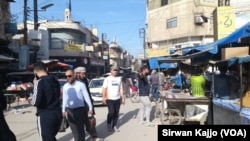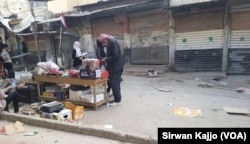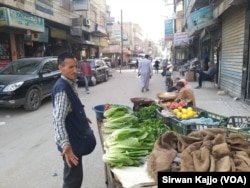Palestine Street, in the heart of the northeastern Syrian city of Hasaka, resembles a typical scene in a conflict-ridden part of the Middle East: a crowded market with customers walking through dust-covered stores while the cries of street vendors give a bustling vibe to the place. Nothing out of the ordinary.
But being the curious reporter that I am, I couldn’t help noticing something odd. Most stores on the right side of the street have painted Syrian flags on their rolling doors. Stores on the other side, however, don't have such signs — or any other signs, for that matter.
A relative who owns a fabrics store on the street noticed my perplexed look.
“I know it’s very strange,” he told me. “That’s because all stores on the right side of the street are under the control of the Syrian government. Those on the left side fall under the control of the Autonomous Administration.”
The Autonomous Administration of North and East Syria (AANES) was established in 2014, nearly two years after the Kurdish-majority region came under the control of Kurdish forces. This was after a rapid withdrawal of Syrian government forces who were deployed to fight rebel forces elsewhere in the early days of the Syrian civil war.
In the years since, major military gains made by the Kurdish-led Syrian Democratic Forces, or SDF, particularly against the Islamic State (IS) terror group, have led to the creation of an expanded Kurdish-controlled authority in northeast Syria.
With the support of a U.S.-led global coalition against IS, the SDF now controls about one-third of Syria’s territory, making it the second-largest entity in the country after the Syrian government-controlled areas.
The Kurdish-led AANES established a governing system that is separate from that of the Syrian government of President Bashar al-Assad. Its rules and regulations are enforced by an expansive security apparatus that includes traffic police, general security forces, anti-terror units and other agencies, some of which were trained by the United States and other Western countries.
But the aspects of control and governance here are not straightforward. And the situation of Hasaka's Palestine Street offers a glimpse into the very complex and delicate power dynamics in this part of Syria.
“Taxes from store owners on this street are collected by two different tax authorities, depending on what side of the street your store is,” said the owner of an electronics store on the Kurdish-controlled side of Palestine Street, a name given to the street by the ruling Baath Party as a sign of support for the Palestinians.
The Syrian government and AANES have different holiday calendars, and respective observances are manifested on this street.
“When there is a holiday observed by the Autonomous Administration, all stores on our side close their doors, while the others on that side remain open, and vice versa,” the store owner said, pointing to the Syrian-controlled side across the street.
There are only a few steps between a Syrian government-manned checkpoint and its Kurdish counterpart, distinguished by the different uniforms worn by the soldiers on each side.
The narrow kilometer-long street leads to what is known as the Security Square, a small pocket that is one of the last areas under the control of government forces in Hasaka. The rest of the city is controlled by Kurdish forces.
Not far from the city center is a major U.S. military outpost, one of several military installations established by the United States as part of its anti-IS partnership with the SDF.
The U.S. has about 900 troops stationed throughout northeast Syria. They have been instrumental in assisting and advising local Kurdish forces in the fight against IS remnants.
But the U.S. is not the only foreign power that has soldiers on the ground here. In the government-controlled pocket in Hasaka and several other areas, Russia, a strong backer of Assad’s government, has established a foothold.
Most of Moscow’s troops were deployed to the region in 2019 following a partial U.S. troop withdrawal that led to a Turkish invasion of parts of northeast Syria. Turkey, which considers the SDF a terrorist organization, has a significant presence in the region after several ground operations against the Kurdish forces.
The presence of so many foreign and local forces, most of whom have been vying for control of this region, has forced local Kurdish authorities to strike a balance, particularly with Syrian government forces, to keep the peace in a country otherwise embroiled in conflict.
Palestine Street represents an uneasy political detente between a nascent governing entity that seeks to thrive against all odds and a weakened central government trying to reestablish a bygone authority. It is also a tangible reminder of Syria’s decadelong conflict that is yet to be settled.
This story originated in VOA’s Kurdish Service.












